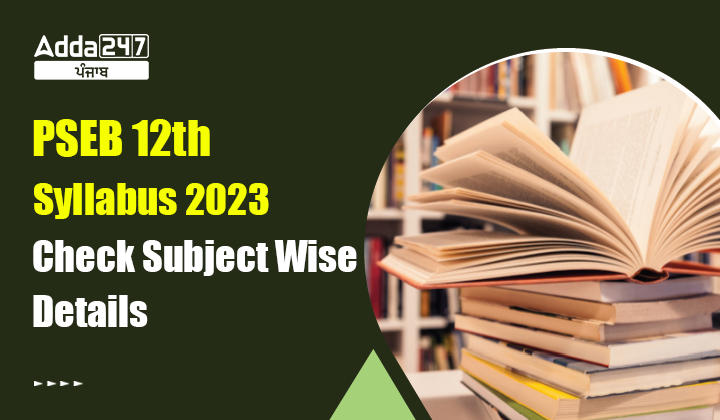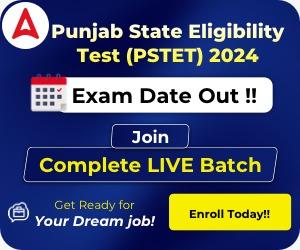PSEB 12th Syllabus 2023: The Punjab School Education Board has released the Punjab Board 12th Syllabus 2023 (PSEB) in pdf format. From the pdf link given in this article, students will get all the information about every new updated syllabus of the Punjab Board for the class 12th exam. There are various topics in the syllabus for class 12th board exams that need to be checked thoroughly. Which subjects are given in the syllabus to get good marks? They need to be followed. Students can get information about all the syllabi to be covered in class 12th with the help of this article.
PSEB 12th Syllabus 2023 Overview
PSEB 12th Class Syllabus: The Punjab School Education Board (PSEB) has released the Punjab Board 12th Syllabus 2023-2024 In PDF format. Students who have appeared in the 2023-2024 session of Class XII. should understand the entire syllabus of Class XII well. It will help you a lot to prepare for Class XII Exam 2023-2024. You can check the summary given in the table below:
|
PSEB 12th Syllabus 2023: Overview |
|
| Conducting Body | Punjab School Education Board (PSEB) |
| Exam Name | PSEB Senior Secondary Exam 2023 |
| Category | Syllabus |
| Status | Released |
| Official Website | pseb.ac.in |
PSEB 12th Subject Wise Syllabus Download PDF
PSEB 12th Syllabus 2023: Students can get detailed information about all the subjects on the official website of PSEB or from the direct link below. Can also download PSEB 12th Class Syllabus PDF. If any changes are made by the Punjab School Education Board then the students will see the updated list on our site.
| PSEB 12th Syllabus 2023: Subject-Wise Syllabus | |
| Download PDF | |
| Download PDF | |
| Download PDF | |
| Download PDF | |
| Download PDF | |
| Download PDF | |
| Download PDF | |
| Download PDF | |
| Download PDF | |
| Download PDF | |
| Download PDF | |
| Download PDF | |
| Download PDF | |
| Download PDF | |
| Download PDF | |
| Download PDF | |
| Download PDF | |
| Download PDF | |
PSEB 10th Syllabus 2023 Check Subject-Wise Details
PSEB 12th Syllabus 2023: English
PSEB 12th Syllabus 2023: From the table given below you will get all the information about the English Subject of the 12th Class.
| PSEB 12th Syllabus 2023: English Syllabus | |
| Section A (Lessons for Intensive Study) | |
| Hassan’s Attendance Problem | Sudha Murthy |
| The March King | Katherine Little Bakeless |
| Thinking Out of the Box: Lateral Thinking | (Adapted from the article from the Internet) |
| On Saying ‘Please’ | A. G. Gardiner |
| The Story of My Life | Helen Keller |
| Two Gentlemen of Verona | A. J. Cronin |
| In Celebration of Being Alive | Dr Christian Barnard |
| Gadari Babas in Kalapani Jail | Dr Harish Puri |
| Section B (Poetry) | |
| Prayer of the Wood | Anonymous |
| On Friendship | Khalil Gibran |
| The Echoing Green | William Blake |
| Once upon a Time | Gabriel Okara |
| Father Returning home | Dilip Chitre |
| The Road Not Taken | Robert Frost |
| On His Blindness | John Milton |
| Section C (Lessons for Extensive Study) | |
| The School for Sympathy | E. V. Lucas |
| A Chameleon | Anton Chekhov |
| Bholi | K. A. Abbas |
| The Gold Frame | R. K. Luxman |
| The Barber’s Trade Union | Mulk Raj Anand |
| The Bull Beneath the Earth | K. S. Virk |
| GRAMMAR, COMPOSITION & TRANSLATION | |
| Grammar | Determiners, Use of Non-finite (Infinitives, Gerunds, Participles), Transformation of Sentences, Voice, Narration |
| Composition | Precis writing, Letter writing (Official/Business/To Editors), Applications Explaining Newspaper Headlines, E-Mail writing |
PSEB 10th Result 2023 Expected Soon Check Punjab Board, Merit List
PSEB 12th Syllabus 2023: Mathematics
PSEB 12th Syllabus 2023: From the table below you will get all the information about the Mathematics Syllabus of the 12th Class.
| PSEB 12th Syllabus 2023: Mathematics Syllabus | |
| UNIT I: RELATIONS & FUNCTIONS | |
| Relations and Functions: |
Types of relations: Reflexive, symmetric, transitive and equivalence relations.
Types of functions: One-to-one and onto functions, the composition of functions and invertible functions. |
| Inverse Trigonometric Functions: |
Definition, Range, Domain, Principal value branches. Graphs of inverse trigonometric functions. Properties of inverse trigonometric functions.
|
| UNIT II: ALGEBRA | |
| Matrices: |
Concept, notation, order, equality, types of matrices, zero and identity matrix, transpose of a matrix, symmetric and skew-symmetric matrices. Operation of matrices. Addition and
multiplication and multiplication with a scalar. Simple properties of addition, multiplication and scalar multiplication. Non-commutativity of multiplication of matrices and existence of non-zero matrices whose product is the zero matrices (restricted to square matrices of order 2). Invertible matrices and proof of the uniqueness of inverse, if it exists; (Here all matrices will have real entries) |
| Determinants: |
Determinant of a square matrix (up to matrices), minors, cofactors and determinants’ applications in finding a triangle’s area. Adjoint and inverse of a square matrix. Consistency, inconsistency and number of solutions of a system of linear equations by examples, solving a system of linear equations in two or three variables (having unique solution) using the inverse of a matrix.
|
| UNIT III: Calculus | |
| Continuity and Differentiability: |
Continuity and Differentiability, derivative of composite functions, chain rule, a derivative of inverse trigonometric functions, derivative of implicit function. Concepts of exponential and logarithmic functions. Derivatives of logarithmic and exponential functions. Logarithmic differentiation is a derivative of functions expressed in parametric forms. Second-order derivatives.
|
| Applications of Derivatives |
Applications of derivatives: rate of change, increasing/decreasing functions, maxima and minima (first derivative test motivated geometrically and second derivative test given as a provable tool). Simple problems (that illustrate basic principles and understanding of the subject as well as real-life situations).
|
| Applications of the Integrals: |
Applications in finding the area under simple curves, especially lines, circles/parabolas/ellipses (in standard form only)
|
| Differential Equations: |
Definition, order and degree, general and particular solutions of a differential equation. Solution of differential equations by the method of separation of variables, solutions of homogeneous differential equations of the first order and first degree. Solutions of linear differential equation of the type:
|
| UNIT IV: VECTORS AND THREE DIMENSIONAL GEOMETRY | |
| Vectors: |
Vectors and scalars, magnitude and direction of a vector. Direction cosines and direction ratios of vectors. Types of vectors (equal, unit, zero, parallel and collinear vectors),
the position vector of a point, negative of a vector, components of a vector, the addition of vectors, multiplication of a vector by a scalar, position vector of a point dividing a line segment in a given ratio. Definition, Geometrical interpretation, properties and application of scalar (dot) product of vectors, vector (cross) product of vectors. |
| UNIT V: LINEAR PROGRAMMING | |
| Linear Programming |
Introduction-related terminology such as constraints, objectives function, optimization, Graphical method of solution for problems in two variables, feasible and infeasible
regions (bounded or unbounded) feasible and infeasible solutions, optimal feasible solutions |
| UNIT VI: PROBABILITY | |
| Probability |
Conditional probability, multiplication theorem on probability, independent events; total probability, Baye’s theorem.
|
PSEB 12th Result 2023 Expected Soon Check Punjab Board, Merit List
PSEB 12th Syllabus 2023: Chemistry
PSEB 12th Syllabus 2023: From the table given below you will get all the information about the English Subject of the 12th Class. Details are given below:
| PSEB 12th Syllabus 2023: Chemistry Syllabus | |
| Unit I: Solutions |
Types of solutions, expression of concentration of solutions of solids in liquids, the solubility of gases in liquids, solid solutions, colligative properties – the relative lowering of vapour pressure, Raoults Law, the elevation of B.P., depression of freezing point, osmotic pressure, determination of molecular masses using colligative properties, abnormal molecular mass. Vant Hoff factor.
|
| Unit II: Electrochemistry |
Redox reactions; conductance in electrolytic solutions, specific and molar conductivity, variations of conductivity with concentration, Kohlrausch’s Law, electrolysis and laws of electrolysis (elementary idea) dry cell electrolytic cells and Galvanic cells; lead accumulator, EMF of a cell, standard electrode potential, Nernst equation and its
application to chemical cells, fuel cells; corrosion. Relation between Gibbs Energy change and EMF of the cell. |
| Unit III: Chemical Kinetics |
Rate of a reaction (average and instantaneous), factors affecting rates of reaction; concentration, temperature, catalyst; order and molecularity of a reaction: rate law and specific rate constant, integrated rate equations, and’ half-life (only for zero and first order reactions); the concept of collision theory (elementary idea, no mathematical treatment). Activation Energy, Arrhenius equation.
|
| Unit-IV:d and f Block Elements |
General introduction, electronic configuration, occurrence and characteristics of transition metals, general trends in properties of the first-row transition metals-metallic character, ionization, enthalpy, oxidation states, ionic radii, colour, electronic configuration, oxidation states, chemical reactivity and lanthanoid contraction and consequences. ctenoids – Electronic configuration, oxidation states.
|
| Unit-V: Coordination Compounds |
Coordination compounds – introduction, ligands, coordination number, colour, magnetic properties and shapes, IUPAC nomenclature of mononuclear coordination compounds, bonding; Werner’s theory VBT, CFT, Isomerism (structure and stereo) importance of coordination compounds(in qualitative analysis, extraction of metals and biological systems).
|
| Unit-VI: Haloalkanes and Haloarenes. |
Haloalkanes: Nomenclature, nature of C-X bond,
physical and chemical properties, mechanism of substitution reactions, optical rotation. Halearenes: Nature of C-X bond, substitution reactions |
| Unit –VII: Alcohols, Phenols, and Ethers |
Alcohols: Nomenclature, methods of preparation, physical and chemical properties (of primary alcohols only); identification of primary, secondary and tertiary alcohols; mechanism of dehydration, uses, with special reference to – methanol and ethanol.
Phenols: Nomenclature, methods of preparation, physical and chemical properties, acidic nature of phenol, electrophilic substitution reactions, uses of phenols. Ethers: Nomenclature, methods of preparation, physical and chemical properties use. |
| Unit-VIII: Aldehydes, Ketones and Carboxylic Acids Aldehydes and Ketones: |
Aldehydes and Ketones: Nomenclature, nature
of carbonyl group, methods of preparation, physical and chemical properties, and mechanism of nucleophilic addition, reactivity of alpha hydrogen in aldehydes; uses. Carboxylic Acids: Nomenclature, acidic nature, methods of preparation, physical and chemical properties; uses. |
| Unit-IX: Organic compounds containing Nitrogen Amines: |
Nomenclature, classification, structure, methods of preparation, physical and chemical properties, uses, and identification of primary, secondary and tertiary amines. Cyanides and Isocyanides – will be mentioned at relevant places in context. Diazonium Salts: Preparation, chemical reactions and importance in synthetic organic chemistry.
|
| Unit-X: Biomolecules |
Carbohydrates – Classification (aldoses and ketoses), monosaccharide (glucose and fructose), oligosaccharides (sucrose, lactose, maltose), polysaccharides (starch, cellulose, glycogen); importance Proteins – Elementary idea of amino acids, peptide bond, polypeptides proteins, primary structure, secondary structure, tertiary structure, and quaternary structure (qualitative idea only), denaturation of proteins; enzymes.
Vitamins: Classification and functions.Hormones: Elementary idea (excluding structure) Nucleic Acids: DNA & RNA |
PSEB 12th Syllabus For All Streams (Arts, Commerce, And Science)
PSEB 12th Syllabus 2023: PSEB 12th Class Syllabus 2023 is the same for all Streams for subjects like English, Mathematics, Punjabi, Computer Science, and EVS. All 12th class students are required to take these subjects, you can get information about all the subjects in the below section.
How To Download PSEB 12th Syllabus 2023
PSEB 12th Syllabus 2023: Students can download the subject-wise list of PSEB 12th Class Syllabus 2023-24. Students who want to download PSEB Syllabus 2023 should follow the below steps.
- Visit the official website pseb.ac.in:
- Click on the Syllabus given under the Important Links section
- The new syllabus of PSEB will open on the screen
- Click on the PSEB Class 12 Syllabus link
- Click on the subject for which the syllabus is required
- A PDF will open which can be downloaded
- Students can print or save it.
PSEB 12th Syllabus 2023: Preparation Tips and Tricks
PSEB 12th Syllabus 2023: For all the students who want to pass the 12th standard exam, we have given some tips and tricks below:
- First to clear PSEB 12th Class Exam 2023
- PSEB 12th Class Syllabus must be seen and understood in detail.
- Preparation by making a good study plan will maintain consistency. With which time can be given for each subject of the PSEB 12th Class Syllabus?
- Apart from this, candidates should study by following good resources.
- Find your strengths and weaknesses.
- With all these Tips and Tricks you can clear the PSEB 12th Class Exam.
| Visit Us on Adda247 | |
| Punjab Govt Jobs Punjab Current Affairs Punjab GK Download Adda 247 App here to get the latest update |











